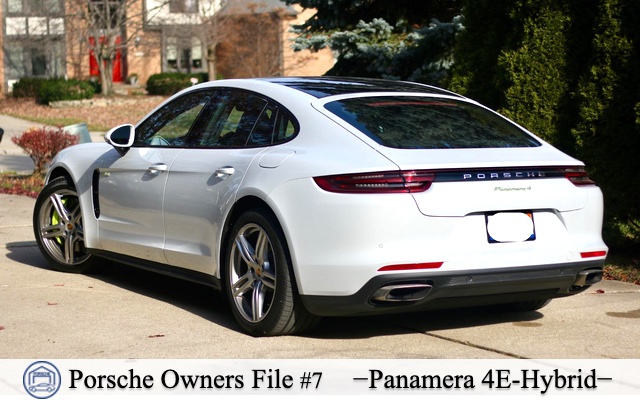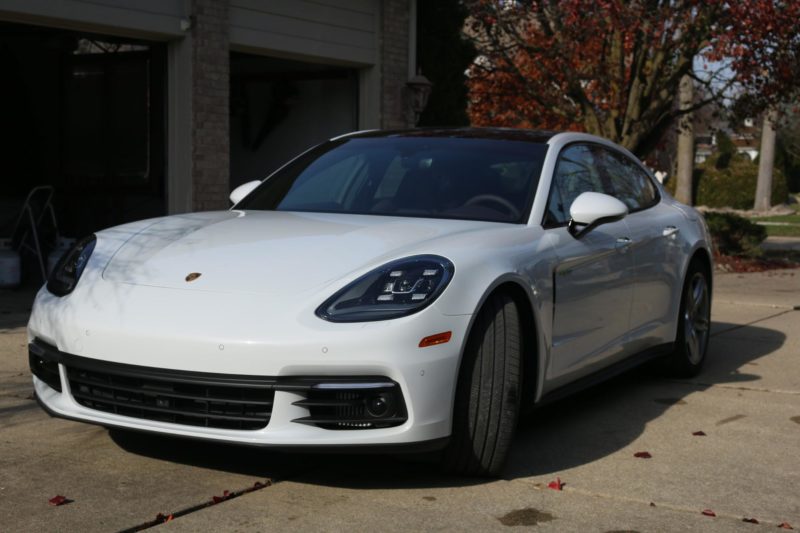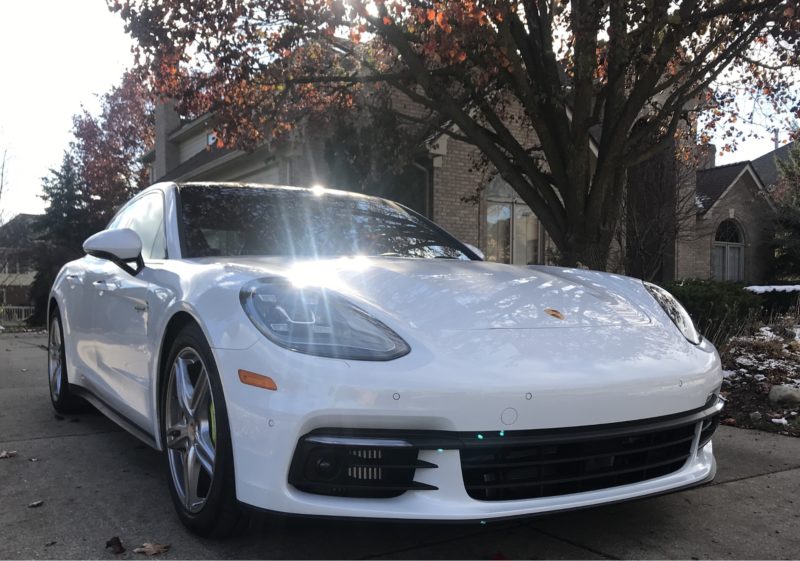Porsche Owners File #7: 971 Panamera 4E-Hybrid Purchase, Options, and Driving Review
公開日:2018.12.11

Hello everyone, this is Mina, the administrator of “Welcome Home, PORSCHE.” Today, I’m thrilled to present the seventh installment of our series, “Porsche Owners File,” a project born from our readers’ desire to hear real voices from various Porsche owners. This time, we’re featuring a review from SN, who resides in the United States, sharing their experience with the purchase, options, and driving review of their “Panamera 4E-Hybrid.” Our blog is gradually expanding globally (laughs).
〘Owner Information〙
・Featured Car: Panamera 4E-Hybrid 2018
・Pen Name: SN
・Location/Residence: United States
・Family Structure: 5 members
・Previous Cars: Alfa Romeo GTV 2000 → Audi A4 2.0 2008 → Maserati Ghibli SQ4 2014 → Volvo XC90 T6 Inscription 2016
・Message to Readers: I believe Porsche’s hybrid technology and performance offer uncompromising sports driving.
1) The Journey to Purchase
− From Italian to German Cars
In the past, I had no interest in Porsche and was more drawn to the allure of Italian cars. My purchase of the Alfa Romeo GTV was driven by my fascination with the unique design by Pininfarina (an Italian company specializing in automotive design, known for its work with Ferrari, Maserati, Alfa Romeo, Peugeot, and others).
However, tastes change over time. The turning point was the Audi A4 I bought for family use. It was an excellent car, and for the first time, I felt I could trust a car completely while driving it.
− Growing Interest in Porsche
Around that time, I started wondering, “What kind of cars does Porsche, the pinnacle of German sports car manufacturers, create?” My interest in Porsche grew, especially after learning about the 919 Hybrid’s success at Le Mans and the impressive hybrid technology. My desire to drive a Porsche sports hybrid car intensified.
I was intrigued by the previous generation 970 Panamera’s soft design, but when the 971 Panamera was released, I was completely captivated and knew “This is it!” leading to my purchase decision.
2) Options/Specifications
■ Body Color: Carrara White Metallic
■ Wheels: 20” Panamera Turbo Wheel with Center Caps Colored Porsche Crest
■ Interior
Leather interior Marsala
Panoramic roof
■ Premium Package Plus: Exclusive to the U.S. market
Comfort access
Soft close doors
Lane change assist
Seat heating front/rear
Power seat 14-way
Bose sound system
PDLS
Seat ventilation front
■ Assistant Package: Exclusive to the U.S. market
Lane keep assist
Adaptive cruise control (Traffic jam assist)
Night vision assist
Rear axle steering including power steering plus
Rear 2+1 seats
Window trim high gloss black
Headrest Porsche crest
− Must-Have Options
In the U.S., options come in packages, but not all were must-haves for me. However,
① Adaptive cruise control
② Traffic jam assist
③ Rear axle steering
were options I definitely wanted. Traffic jam assist is incredibly effective in reducing fatigue and stress during long drives and traffic jams, so it was a must. Although the dealer said rear axle steering wasn’t necessary, I decided to include it after reading comments on Mina’s husband’s blog.

− Favorite Features
One of my favorite details is the high gloss black finish on the window trim. The contrast with the white body is stunning. I considered matching the mirrors, door handles, and air intakes in gloss black, but after seeing a Panamera with that setup on display, I felt it was a bit much and opted for just the window trim.

− Convenient Rear 2+1 Seats
With a family of five, a four-seater was not an option, so I initially considered the Panamera Sport Turismo (five-seater). Then I discovered the “Rear 2+1 seats” option, which allowed me to keep the Panamera’s design I loved while accommodating five people.

(Even with a child seat in the center, there’s enough space for adults on either side.)
3) The Delivery Process
① August 28: First Visit to the Dealer
They said, “We don’t have an allocation for the 2018 Panamera 4E-Hybrid, but it seems other state dealers do, so we’ll ask if we can swap.” The next day, I received a call saying, “You can order it. Come back if you’re interested!”
② August 31: Order Completed at the Dealer
Delivery was scheduled for the end of January.
…No contact for over a month.
③ October 11: Called to Check on Progress
“Hold on, let me check. Oh, it’s leaving the German port tomorrow. We should be able to deliver it by early November.”
④ November 10: Arrived at the Dealer
“We’ll complete the registration and can deliver it early next week. You can pick it up or we can deliver it—your choice.” I decided to pick it up myself.
⑤ November 12: Delivery Day!
…Or so I thought, but there was a paperwork issue, so I had to wait another day. I took a short drive around the dealer area.
⑥ November 13: Decided on Delivery
The dealer representative drove it to me right on time. “I doubt a dealer rep would personally deliver a car in Japan,” I thought, but I didn’t mind the details (laughs). After driving around the neighborhood and learning various settings, I dropped off the rep, who left with a big “Enjoy!!” smile.
4) Performance Impressions of the Panamera
① Engine
The engine I compare it to is the V6 twin-turbo from my previous Maserati Ghibli. While it’s a bit odd to compare it to a hybrid engine, the 4E-Hybrid’s motor and engine synchronization is remarkable. It accelerates seamlessly from any speed, transitioning from motor assist to turbo engine. “This is truly a modern race car!” I couldn’t help but feel excited.

− Acceleration from a Standstill
Especially from a standstill, the motor’s responsiveness allows for instant acceleration without the turbo engine’s lag, pressing you into the seat as you accelerate. If engine acceleration feels like “stretching out,” the motor feels like “being launched.”
− Vehicle Weight Handicap
The Panamera weighs 4784 lbs compared to the Ghibli’s 4122 lbs, a difference of 660 lbs (297 kg). Some reviews criticize hybrids for this weight, but in everyday use, I don’t encounter situations where this is a disadvantage.
− Acceleration Feel
The acceleration feels superior to the Ghibli. Thanks to the motor, maximum torque is available from a low 1100 rpm to 4500 rpm, which is a major factor. This E-Hybrid’s power and torque are most noticeable in Sport and Sport+ modes, but even in Hybrid mode, it’s impressive.
− Engine Mode & E-Mode
Initially, when driving in “hybrid e-charge mode,” it felt like “driving with the engine while the motor is off,” but even in e-charge mode, the motor assists when needed.
In E-mode, you can experience the motor’s quiet yet sufficient acceleration. With a maximum torque of 295 lb-ft from the motor alone, it’s very pleasant for city stop-and-go driving. Once accustomed, you might want to stay in E-mode, but its top speed is 137 km/h, which can be limiting on highways flowing at 120-130 km/h. (Speed limits are 112-120 km/h).
While acceleration from zero is excellent, E-mode isn’t suited for mid-to-high-speed acceleration. However, pressing the accelerator deeper in E-mode starts the engine, so you won’t lag behind traffic.
② PDK
The PDK paddle shift response is quick for both upshifts and downshifts, and I think it can be very enjoyable in certain situations. Unfortunately, I haven’t had the chance to test it much due to the lack of winding roads nearby.
The timing of AT upshifts and downshifts changes depending on the mode—Normal, Sport, Sport+—and this is noticeable even in city and highway driving. However, there aren’t many opportunities to use the paddle shifters.

③ Handling
Having previously raced go-karts, I prefer sensitive steering responses, and the Panamera reminds me of that experience. It turns precisely as you steer, following the intended line.
− Benefits of Rear Axle Steering
The power steering feels generally light, more relaxed than the Maserati Ghibli. Setting the air suspension to Sport mode enhances steering sensitivity, allowing you to navigate large highway curves as if they were straight lines. This is likely due to the rear axle steering’s long-wheelbase effect.
Even in large, circular highway exits, it maintains stability without oversteer or understeer, requiring no additional input. In Michigan, where U-turns are common, the rear axle steering’s short-wheelbase effect is beneficial.
Previously, I needed the entire lane to turn, but now I can make tighter turns without strain. It’s a different sensation from oversteer, where the rear slides; instead, the car’s direction changes sharply. It’s hard to describe, but that’s the feeling.
Parking requires some adjustment due to the unexpectedly tight turning radius, which can be surprising.
| →【Next Page】 Fuel Efficiency, Ride Comfort, Family Reactions, Rear Axle Steering… |
このブログが気に入ったらフォローしてね!


Comment ( 0 )
Trackbacks are closed.
No comments yet.